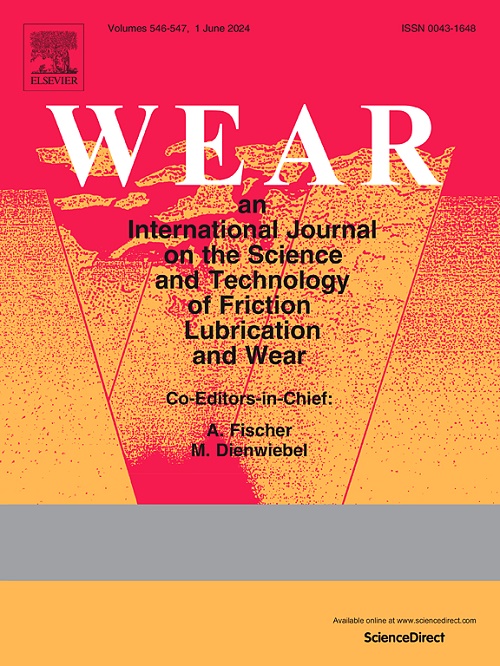Influence of subsurface non-metallic inclusions on rolling contact fatigue behavior in bearing steels - Experimental and numerical investigations
IF 5.3
1区 工程技术
Q1 ENGINEERING, MECHANICAL
引用次数: 0
Abstract
The early failures in rolling bearings made of 100Cr6 (SAE 52100) steel have been observed in various industrial applications, which are associated with high maintenance and downtime costs. The damage is usually characterized in the form of axial cracks or volumetric breakouts on the running surface of the bearing components. Metallographic examinations revealed areas below the raceway that do not react to etching with alcoholic nitric acid and therefore appear visually white. These areas are referred to as “white etching areas” or “WEA” for short. Cracks that lead to bearing damage along these WEA are accordingly referred to as “white etching cracks” (WEC). This subsurface damage initiated from non-metallic inclusions has been identified as the dominant initiation mechanism in the formation of butterflies. This study presents a comprehensive analysis of the intricate mechanisms governing the formation of butterflies in SAE 52100 bearing steel, utilizing multiscale finite element modeling and detailed microstructural investigations. The research offers valuable insights into the role of non-metallic inclusions, such as MnS, in butterfly formation, emphasizing that MnS influences butterfly formation through its size, orientation, and interactions with the inclusion-matrix interface. Moreover, it classifies butterflies into propagating and non-propagating types based on their interactions with the inclusion-matrix interface, revealing that non-propagating butterflies can coexist within the steel without causing bearing failure under specific conditions. In contrast, propagating butterflies, which lead to WEA formation, are unequivocally linked with bearing failure.
地下非金属夹杂物对轴承钢滚动接触疲劳行为的影响。试验和数值研究
在各种工业应用中已经观察到100Cr6 (SAE 52100)钢制成的滚动轴承的早期故障,这些故障与高维护和停机成本有关。这种损伤通常表现为轴承部件运行表面的轴向裂纹或体积破裂。金相检查显示,滚道下方的区域对含酒精的硝酸蚀刻不起反应,因此在视觉上呈白色。这些区域被称为“白色蚀刻区域”或简称“WEA”。沿着这些WEA导致轴承损坏的裂纹相应地被称为“白色腐蚀裂纹”(WEC)。这种由非金属夹杂物引发的亚表面损伤已被确定为蝴蝶形成的主要引发机制。本研究利用多尺度有限元模型和详细的微观结构研究,对SAE 52100轴承钢中蝴蝶状形成的复杂机制进行了全面分析。该研究对非金属包裹体(如MnS)在蝴蝶形成中的作用提供了有价值的见解,强调MnS通过其大小、取向以及与包裹体-基质界面的相互作用影响蝴蝶的形成。此外,根据蝴蝶与夹杂物基质界面的相互作用,将蝴蝶分为繁殖型和非繁殖型,揭示了非繁殖型蝴蝶可以在特定条件下共存而不会导致轴承失效。相反,导致WEA形成的繁殖蝴蝶与轴承故障明确相关。
本文章由计算机程序翻译,如有差异,请以英文原文为准。
求助全文
约1分钟内获得全文
求助全文
来源期刊

Wear
工程技术-材料科学:综合
CiteScore
8.80
自引率
8.00%
发文量
280
审稿时长
47 days
期刊介绍:
Wear journal is dedicated to the advancement of basic and applied knowledge concerning the nature of wear of materials. Broadly, topics of interest range from development of fundamental understanding of the mechanisms of wear to innovative solutions to practical engineering problems. Authors of experimental studies are expected to comment on the repeatability of the data, and whenever possible, conduct multiple measurements under similar testing conditions. Further, Wear embraces the highest standards of professional ethics, and the detection of matching content, either in written or graphical form, from other publications by the current authors or by others, may result in rejection.
 求助内容:
求助内容: 应助结果提醒方式:
应助结果提醒方式:


